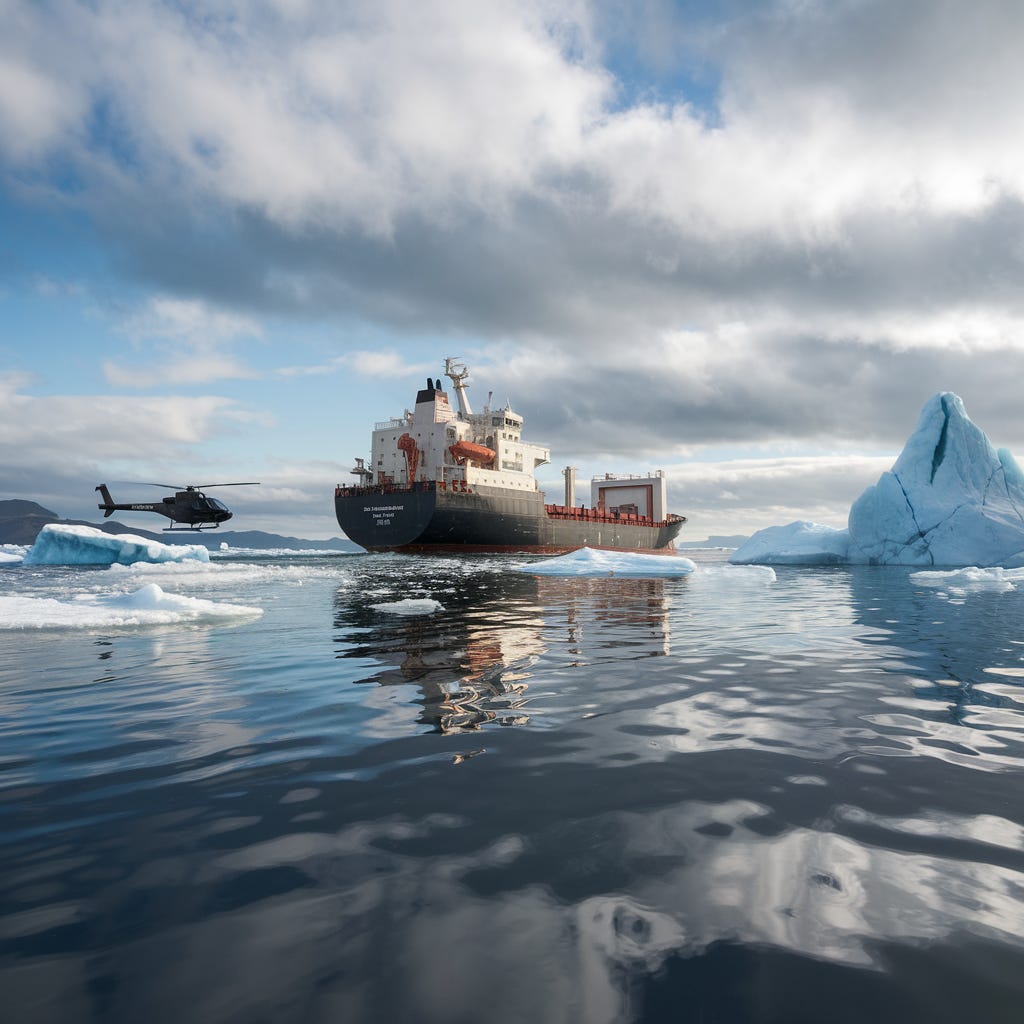This is Pt. 4 of the “It’s Getting Hotter in the Arctic” series. For the first part of the series, click here, for the second part click here, and for the third part click here. Ice guaranteed! 🧊
You’ve waited for this your whole life. As a career diplomat, you’re about to get reassigned, and you’re ready to be posted to one of the luxurious capitals of Europe. Paris sounds nice this time of year, and you can’t go wrong with a stint in London. Ahhh, the prospects of fancy dinner parties and swanky hotels do sound appealing after 30 years in some of the world’s most God forsaken places. The Great Rest is on…!
But not so fast. Your new posting arrived. Congrats - you’re the new ambassador to the Arctic!⛄❄️🥶🧊
Time to pack your bags and board a flight ✈️
At this point, I hope that I’ve managed to convince you that there’s something important happening in the Arctic, and we should be paying attention to it. We explored the shifting geopolitical tides, natural resources, and the opening of new shipping lanes. The Arctic is a place where many interests and aspects come together. Perhaps the most notable case of this convergence can be found on the Polar Silk Road.
A New Silk Road?
The original Silk Road was (still is?) a Eurasian network of trading routes used to pass goods from east to west and served as the arteries of the global economy. While the origins, nature, and importance of the Silk Road are a thing of historical investigation, it is without doubt that the term is widely used to evoke notions of trade and economic relations*. It is no surprise then that China has decided to name its ambitious project to connect Europe and Asia - the Polar Silk Road.
Announced in 2018, The Polar Silk Road (the “PSR”) is an ambitious expansion of the Belt and Road Initiative, designed to connect Europe and Asia in a way that will facilitate trade and position China as a meaningful player in the Arctic. Unlike the original Silk Road, the PSR is a waterway; the Northern Sea Route, to be specific (hey, recall the deep dive we did on the topic?!).
*For those interested in reading more, I highly recommend Peter Frankopan’s “Silk Roads”!)
How Do You Build a Silk Road at Sea?
Great question.
If we were on land and wanted to build a new silk road, we probably would have either paved asphalt🛣️ or built railways🚈. Take your pick. But since we cannot do that at sea, the meaning of building the PSR is mostly concerned with the supporting infrastructure:
Ports and Facilitites: Deep sea ports and logistical hubs to allow ships to dock
Energy Infrastructure: Infrastructure to take advantage of resources in the area
Transportation: Railways and roads to connect docks and other infrastructure and to allow easy and quick access to logistical hubs
It’s not so much a matter of building the PSR as it is establishing it. This requires a more nuanced and complex set of actions and conditions to change the flow of goods and services in a volume large enough to shift global trade dynamics; akin to how the establishment of sea trading routes from the Americas to Europe in the 1500s changed the global commercial landscape. To be successful, China would need to navigate complex (and frozen) waters and overcome many obstacles. The question is… why bother?
Venturing into the PSR
“Nothing works around here” you mumble to yourself, trying to get the heater to work at some defunct, remote base. Your renovated home base should be ready at some point, but until then you’re out of luck and stuck here. What’s an Arctic Ambassador anyway, you wonder. It’s practically a series of icebergs.
One day, as you’re trying to fix the radiator once again, you hear one of your military colleagues use the term “Polar Silk Road”. Your eyes light up - finally, a chance for some high class travel, maybe an Italian roast espresso or a decent internet connection. “When are we hoppin’ aboard?” you ask with enthusiasm. “Not so fast”, your colleague says. You’re disappointed after hearing that it doesn’t really exist, and there’s no Italian roast at the Yamal LNG depot, but something becomes apparent: your ambassdorship is going to get a lot hotter than you thought…
The PSR, as mentioned above, is a project where shipping, natural resources, geopolitics, the environment and even Science(!) converge. The prospects of changing the global balance of power through trade and geo-flexing shows why the PSR is important to China. To be clear, it’s not that the PSR is China’s top priority at the moment, but there is evidence that China sees the PSR as a vital asset to be cultivated as a long-term strategy.
Shipping, Once Again
At its core, the PSR is a maritime trading route that requires infrastructure to be built and developed, including a capable fleet (Polar-Class ships, anyone?). To this end, China is already working on developing its polar fleet.
With the increasing rate of ice🧊 melt in the Arctic, it is only a matter of time until the Northern Sea Route (NSR) becomes ready for broader use. The NSR is an Arctic shipping route that has potential to reduce the travel time from Europe to Asia and is controlled by Russia. To unlock its potential, infrastructure would need to be built, an investment unlikely to be carried solely by Russia (at least within the NSR). Enter China..
China is planning, through its partnership with Russia and other countries, to build extensive infrastructure and develop this route, “paving” the way for China to increase its influence in the Arctic region.
So… shipping lanes and sea routes? Check✅
Economic Development & Natural Resources
The PSR is not only about opening of shipping lanes. The PSR includes, in theory at least, economic development projects. Making the Polar Silk Road economically worthwhile is not just about making shipping happen, but also requires investing in natural resource extraction.
Currently, the most meaningful of the PSR economic development projects is the investment in the Yamal LNG Depot, a large project designed to generate up to 5.5 million tonnes a year of liquified natural gas. Developing the Yamal LNG Depot includes building train infrastructure, an international airport, a sea port, LNG tankers (and more!) that can withstand the harsh working conditions (yeah, it’s even colder than you’d expect, with temperatures dropping to a bone-chilling -57C and entire months passing under the cover of darkness). This is no easy prospect, with numerous contractors and oodles of cash required to finance the project💰💰💰
Due to Western sanctions on Russia, the project had been quite stuck in limbo over the past few years, until recently, when the project managed to secure a $12B loan from Chinese lenders.
Of course, other than the Yamal project, there are a host of other projects that are underway: Arctic LNG2, Payakha Oilfield, Zarubino Port, Arkhangelsk Deep Water Port, and others. How’s it going with those projects? Not great, thanks for asking. But that’s for another time…
At any rate… natural resources? Check✅
Geopolitics
If I told you that geopolitics are involved with the PSR, would you be surprised? I hope that by now the answer is no.
China is not an Arctic state, but rather a self-proclaimed “near-Arctic State” (with the Arctic being at least 900 miles away… kinda near, I guess…). China is an observer on the Arctic Council and cannot operate in the Arctic as it sees fit (with some exceptions), making it dependent on Russia as a partner to promote the PSR.
Putting aside the PSR’s prospects of success, this partnership keeps the US and other Arctic countries up at night and leads to increased tension in the region. This partnership includes not only economic developments, but also “bang-bang pow-pow”🪖🔫 military collaborations between China and Russia, including Russian and Chinese bomber plane drills off the coast of Alaska and mutual sailing exercises. Never gets boring over there…
As the PSR continues to develop, China is tightening its grip on the Arctic. It is likely that we will see increased military collaborations in the region to bolster China’s positioning in an attemp to show other countries who’s boss.
Geopolitcal muscle-flexing?💪 Check✅
Bonus Point: Scientific Research
Yeah, a bunch of scientists drilling in the Arctic is not the first thing you think about when discussing the PSR and China’s ambitions, but scientific research is one of the earliest and most common forms of Arctic collaboration.
Russia’s invasion of the Ukraine has upended and disrupted collaboration, but that still does not change China’s usage of scientific research to enhance its position in the region. Being an observer on the Arctic Council, scientific research is one of the few activities China can pursue on its own.
So… scientific research? Hell Yes! ✅
Mmmm’Kay, who cares?
Fast-forward a few years, you’re still stuck in that same base, and you haven’t had Italian roast in a while. But you don’t care. You have bigger fish to fry, and are knee-deep in icy froth. Your country sent you to create alliances and collaborations, to court developers, and create an alternative to the Polar Silk Road.
It’s not easy. You’re late into the game, but it’s why you joined the service. You’re fully on board the new Arctic frontier, where a new Great Game is being played, and for once, you feel like a player. The Great Rest will have to wait.
Now, if you could only get that heater to work…
It’s too early to tell whether the PSR will be a success and position China as a force to be reckoned with in the Arctic or not. Be the fate of the PSR be as it may, its mere existence shows just how important the Arctic is to countries outside of the Arctic Council. The PSR, as we mentioned above, encapsulates the complexity of the Arctic region and captures the Arctic zeitgeist.
To me, the PSR encapsulates something bigger than the sum of its economic, geopolitical, scientific, and maritime parts; it shows the Reconfiguration at work in all of its glory.
Still, the operating question is “who cares?” I think it should be all of us:
👉 At the macro level, we are likely to see more and more instances of large-scale projects, akin to the PSR, led by ambitious parties seeking to take advantage of the prospects of a thawing Arctic. This competition could accelerate the destabilization of the region - both militarily and environmentally.
👉 What if China succeeds in operating the PSR? Hindsight is 2020, but history is full of examples of how the rewriting of trade routes change the global balance of power. Think Portugal and Spain of the 16th Century. Will we see the Arctic helping propel China to the status of the dominant super power? At the very least it will weaken US hegemony over the region and provide another point of strength to the BRICS side of the equation.
👉 Business opportunities. If you’re in the shipping industry, in construction, or in energy, you should pay attention. It’s only a matter of time until NATO countries figure out they should engage in projects on a similar scale and vision.
👉 Speaking on vision, what’s the NATO vision for the Arctic? Clearly Russia and China have one. The PSR is a great window into what role the Arctic plays in their vision of the region and the world. Should NATO think in similar fashion?
👉 Climate-wise, the PSR means accelerated regional development that could further destabilize the local ecosystems and continue to accelerate Arctic thawing ad-infinitum. What price are we willing to pay for economic development?
Whatever angle you choose to focus on, the PSR gives us a glimpse into what the future may hold. There’s no telling what will happen specifically (the PSR might be abandoned, it may fail, it may be a stellar success for China). However, the type and scale of the project shows just how climate change is reconfiguring the way nations and companies are competing for hegemony in the region, with ever growing ambitions. It’s likely that we will see other development projects and more attempts to take advantage of what the Arctic has to offer.
On the other hand, as was the case with natural resources, these ambitions will come at a costly price, at a time that humanity cannot afford to continue to destabilize our planet and its local ecosystems. Can we resist? I’m not sure.
Next up, we’ll recap this series and try to think about Arctic governance and the future of the region. Arrivederci👋
If you’ve liked this post, please help us grow:











